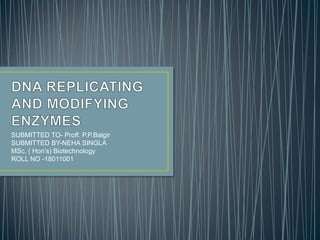This document discusses various enzymes used for gene cloning. It describes restriction endonucleases that cut DNA at specific recognition sequences, leaving sticky or blunt ends. DNA ligase joins compatible DNA ends. DNA polymerases synthesize new DNA strands. Other enzymes mentioned include DNA modifying enzymes, topoisomerases, and enzymes for tailing DNA ends. The document provides examples of various restriction enzymes and their recognition sequences. It explains how enzymes are used in gene cloning techniques.



























































